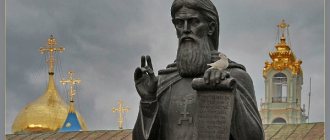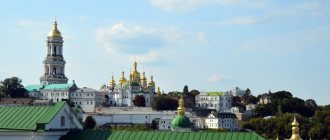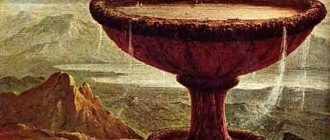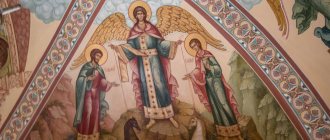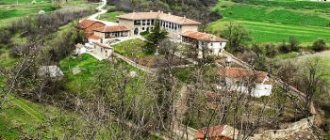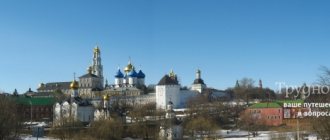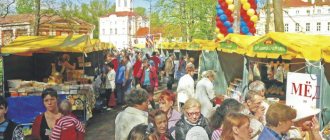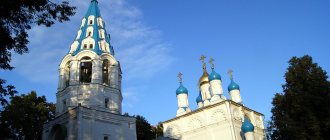On the high stone cape of the Kremenets Mountains lies the majestic architectural ensemble of the Pochaev Lavra, dazzling with the gold of its domes and the snow-white purity of its walls. Founded in the 14th century by two ascetic hermits, the Orthodox shrine has gone through many dramatic pages, and its history is covered in numerous legends.
The Turkish siege and aggression of Saxon troops, destructive wars and the struggle of confessions, militant atheism and difficult events of our time did not break the spiritual strength of the holy stronghold of the Christian faith. Under the protection of the Miracle-Working Icon of the Mother of God and the Footprint of her foot with healing water, the holy relics of Job and Amphilochius, the Lavra continues to fulfill its eternal mission - to serve as a spiritual light for pilgrims who need spiritual and physical healing and seek to find bright inner joy in spiritual sources.
We bring to your attention some interesting legends and facts from the history of the Pochaev Lavra, which you can also hear about on the tour “Pochaev + the source of St. Anne”
Pochaev Icon of the Mother of God
The Royal Doors of the Assumption Cathedral are crowned by the Miraculous Pochaev Icon of the Mother of God in the star of the icon case, decorated with precious stones. Brought to Volyn by the Greek Metropolitan Ieophyte, the shrine was transferred to the monastery at the end of the 16th century. by his patron Anna Goyskaya after the miraculous healing of the landowner's brother, who was blind from birth.
On especially solemn holidays, the Icon, the stronghold of the monastery’s prayer life, is lowered down to the believers, who reverently absorb its gracious warmth and healing power.
History of the foundation of the monastery
Pochaev Lavra is located on a natural hill with natural rock grottoes. According to legend, hermit monks from the Kiev Pechersk Monastery stopped here, who fled from the Tatars in 1240. One day two monks saw the Most Holy Theotokos standing in a pillar of fire on the top of a mountain. The Mother of God stood with a crown on her head and a scepter in her hand. The monks regarded the vision as a blessing from the Most Holy Theotokos to found a new monastic monastery here. The imprint of the right foot of the Mother of God remained on the stone. Healing water began to flow from it, from which many believers received healing from various diseases. Soon, the Assumption Church was built on the southern slope of Pochaevskaya Mountain (now there is a chapel here). This is how the history of the Pochaev Monastery began.
There are several versions of the origin of the name of this place. According to one, the Kyiv monks named the mountain of their solitude in memory of the Pochayna River, the right tributary of the Dnieper. According to other sources, after the appearance of the Blessed Virgin Mary on the top of the mountain, a saying spread among the local population: “Pocha Diva work miracles” (“The Virgin began to work miracles”). From the words “Pocha” and “Diva” the name was formed - “Pochaiv” (Pochaev).
In the 14th century, most of Kievan Rus came under the rule of Lithuanian princes, who initially patronized the Orthodox Church. However, in the 15th-16th centuries the situation changed - Catholicism began to be forcibly imposed on Western Russian lands. Under these conditions, the Pochaev Monastery became a stronghold of Orthodoxy in the Volyn lands.
The existence of the Pochaev Monastery was first mentioned in the Chronicles of 1597. Local landowner Anna Goyskaya donated land and a miraculous image of the Mother of God to the monastery. Her will was the preservation of the Orthodox faith and rituals of the Eastern Church.
Nikolai Pototsky - from adventurer to monk
The story of the reincarnation of the count, known for his scandalousness, into a philanthropist and monk is also connected with the miraculous power of the Icon of the Mother of God. Legend has it that while driving past the holy walls, the count overturned along with his carriage, for which, in an angry fuse, he decided to shoot the coachman. But the pistol misfired three times after the servant’s heated appeal towards the monastery to the Pochaev Icon.
Shocked by this miracle, Pototsky decided to devote his future life to the development and strengthening of the monastery, in particular, the construction of the majestic Assumption Cathedral and the coronation of the Miracle-Working Icon. Count Pototsky ended his life in a small house near the Lavra, shortly before his death he became a monk.
Current state
Currently, the brethren of the Pochaev Lavra consist of about 200 monks and 50 novices. The abbot of the monastery since 1996 is Metropolitan Vladimir (Moroz) of Pochaev, vicar of the Kyiv diocese.
A theological seminary has been operating in the monastery since 1994. There is a pilgrimage hotel and a publishing house on the territory of the monastery. The Monastery of the Holy Spirit has been operating at the Lavra since 1990 (the first information about it dates back to the 13th century; it was closed in 1960).
Every year on August 19, a religious procession takes place from the village of Dovzhok near the city of Kamenets-Podolsky to the Pochaev Lavra (20 thousand people took part in it in 2018).
Schemamonk Amfilohiy
In one of the cave-cells of the Lavra there is a tomb with the relics of a man canonized at the beginning of the 21st century. schema-abbot Amphilochius of Pochaev, known during his lifetime far beyond the monastery for his gift of healing physical and spiritual ailments.
A true folk healer completely disinterestedly helped UPA soldiers and relatives of party bosses, thousands of ordinary people, despite persecution by the authorities during the difficult times of Soviet atheism. Thirty years after the burial, the schemamonk’s body was exhumed incorrupt and placed for worship in the cave Temple of St. Job of Pochaev.
You may also be interested in another pilgrimage tour “Zarvanitsa + Envy + Tyutkov”
History[edit]
Appearance of the Mother of God on Pochaev Mountain
The monastery was founded on a mountain near the town of New Pochaev around 1240-1241. The first founders of the monastery were hermits of the Kiev Pechersk Lavra, who fled to Volyn from the Horde devastation. History has not preserved their names. From the oldest chronicle of the Pochaev monastery, only one fact has been preserved, proving that the monks were on the mountain back in 1240, because two of them, with a resident of the village of Pochaev, the shepherd Ivan Bosy, according to legend, saw in that year the appearance of the Mother of God standing on the Pochaev rock in a fiery form. In the place where the Most Holy Theotokos stood, there remained a trace of Her Foot, filled with clean and healing water. Then, probably, at the foot of the mountain a stone church was built by monks in honor of the Dormition of the Mother of God.
Over time, the monastery began to fall into disrepair. The monastery was built again with the diligence of the landowner Anna Goyskaya, who brought here in 1597 the miraculous icon of the Mother of God from her own Orlinsky monastery. This happened after Goyskaya’s brother Philip Kozinsky, who was born blind, regained his sight in front of the icon. Before its transfer, the icon was kept in the house of the landowner for about 30 years and was received by her from the Greek Metropolitan Neophytos as a gift for the hospitality shown to him.
When in 1596 the Polish government proclaimed a union, the Pochaev Lavra resolutely opposed the spread of the Jesuit system and the Catholicization of the Orthodox, steadfastly withstood the onslaught of alien faiths and became a powerful spiritual center of Orthodoxy. During the time of Lithuanian rule in Volhynia, the most important spiritual figures of the Lavra and the most implacable opponents of the Latin-Polish predominance and union were the Monk Theodore, Prince of Ostrog, the holy Metropolitan Photius, the Monk Job, abbot of the Pochaev monastery (+ 1651) and the holy martyr Macarius, Archimandrite of Ovruch (+ 1678 ). The activities of the Monk Job of Pochaev transformed the monastery - he introduced a hostel here, surrounded the monastery with a fence, built seven churches, and created a printing house to protect Orthodoxy.
In 1675, the Pochaev Monastery was besieged by the Tatars. On the third day of the siege, during the reading of the akathist, the Queen of Heaven Herself appeared over the monastery. The Tatars tried to shoot arrows at the heavenly phenomenon, but the arrows came back and hit them. Then the Tatars fled.
From 1713 to 1831 the monastery was under the rule of the Uniates, in the hands of Basilian monks. They revered the Pochaev Icon of the Mother of God, but at first they closed access to the relics of St. Job to the Orthodox, although they could not hold back the believing people for long.
On October 25, 1831, the monastery was returned to the jurisdiction of the Orthodox clergy, and the department of the Volyn diocese was located here. In 1833, the monastery received the status of a monastery, giving it fourth place among those existing in Russia. At the same time, the holy archimandrites of the Pochaev Lavra were the Volyn, and in the 1840-1860s - the Warsaw bishops. In the early 1840s, the Lavra was also the seat of the Ostroh vicar.
Venerable Job of Pochaev
The Cathedral Church of the Assumption of the Mother of God was built by the famous benefactor of the monastery, Count Nikolai Pototsky in 1780. Subsequently, two chapels were erected in it: one in 1842 in the name of St. Nicholas the Wonderworker and the other in 1859 in honor of St. Alexander Nevsky. In the cathedral church above the royal doors, in a star-shaped icon case, the famous miraculous Pochaev Icon of the Mother of God was placed. In the cave church of the Holy Trinity, the relics of St. Job of Pochaev rested in a silver shrine, built in 1842 by Countess Anna Alekseevna Orlova-Chesmenskaya.
At the Lavra there was an icon-painting workshop, a school with training in various crafts for 25 boarders, three hotels and a hospital for visiting pilgrims.
In 1914, during the First World War, everything of any value was removed from the Lavra: from bells to archives, libraries and candle factories. The miraculous Pochaev image of the Mother of God and the relics of St. Job in a silver shrine were delivered to Zhitomir, where they remained until 1918. Most of the brethren were evacuated to the Svyatogorsk Hermitage of the Kharkov diocese. 18 people wished to stay in the Pochaev monastery. However, the Austrians, who occupied the monastery in August 1915, sent them to Hungary to a prisoner camp, and robbed the monastery itself as much as possible. In May 1916, as a result of Brusilov's offensive in Galicia, Russian troops arrived in Pochaev. Divine services are resumed in the Lavra, monks return, and the economic life of the monastery begins to improve.
During the revolutionary hard times, fighting did not subside around the Lavra. The inhabitants hid most of the Lavra’s shrines, and they themselves worked with only meager supplies. At the beginning of 1919, the Lavra was again captured by the Bolsheviks, who plundered the last property that still remained there, but there was no bloodshed. On September 8 of the same year, these lands were occupied by the Poles, and in 1920, the west of Volyn officially became part of the newly independent Poland.
Until 1939, the monastery belonged to Poland and was part of the Polish Orthodox Church. The existence of the Lavra as an Orthodox monastery was then threatened by “revindication” - the transfer of churches to the Roman Catholic Church. The entire Orthodox world opposed it and defended its shrines. Since 1925, a monastic school and a number of economic institutions operated in the monastery. At the same time, the traditions of the Pochaev Lavra and its printing house receive a new continuation in emigration - in the Ladomirovsky Monastery of St. Job, which in 1946 moved to the USA, becoming part of the Jordanville Trinity Monastery (ROCOR).
In 1939, after the annexation of the western regions to the eastern part of Ukraine, the Lavra entered into prayerful communion with the Russian Church. Episcopal consecrations were performed in the Lavra, including Lavra monks Veniamin (Novitsky) and Demetrius (Magan), for various cities of Ukraine. The so-called “new building”, where the printing house, icon painting, and monastic hospital were located, as well as the monastery mill, the bishop’s house, and the candle factory were taken away from the monastery, along with fields, forests, gardens and household equipment. And yet the monastery lived.
The Pochaev brethren write a letter to the UN in defense of the Lavra, 1963.
During the German occupation during World War II, the Lavra belonged to the canonical Ukrainian Autonomous Church, maintaining communion with the Moscow Patriarchate. Here the monk of the Lavra, Bishop Veniamin (Novitsky), had his residence, and pastoral courses were held.
During the Soviet period, deprived of many lands and opportunities, the Lavra continued to be a stronghold of Orthodoxy, such saints as the Venerable Kuksha of Odessa and Amphilochius of Pochaev labored here. In the 1960s, the Lavra withstood a new wave of anti-religious persecution, but was not closed.
In contrast to the oppression, the monks wrote many appeals to higher authorities. They wrote to His Holiness Patriarch Alexy I, to the Council for Religious Affairs, and wrote especially a lot to the authorities, both local and All-Ukrainian and All-Union. But all these appeals were largely unsuccessful. The author of religious and educational programs of the Russian BBC service, Bishop Vasily (Rodzianko), believed that the fate of the monastery was positively influenced by the participation of Metropolitan Anthony of Sourozh, who brought to the editorial office eighty letters from the USSR, on the basis of which a special radio broadcast was made about the oppression of monks and the intention close the laurel. In the subsequent decades of the Soviet regime, the authorities again attempted to destroy the Lavra, but to no avail. During this period, the holy archimandrites of the Lavra were the Lviv bishops.
With the collapse of the USSR, the pressure of the atheistic authorities weakened, the Lavra was able to expand its activities - the Lavra Holy Spiritual Skete was opened, the museum building was returned to the Lavra in the city of Kremenets, since 1991 the Lavra educational institution was resumed - as pastoral courses, as a theological school, and since 1994 already as a spiritual semiary. But the new secular authorities of Ukraine were often hostile to the Lavra for its loyalty to the canonical system of the Church and refusal to deviate into the newly implanted union and schism.
Since 1990, the vicars of the Lavra are usually in the rank of bishop, with the title of Pochaev, vicars of the Ternopil, and since 2000 - of the Kyiv diocese. Since 1996, the Lavra has been a stauropegial monastery of the Ukrainian Orthodox Church. In 2013, it was the largest monastery in Ukraine.
Pochaev Lavra - an outstanding monument of architecture and art
The architectural ensemble of the monastery was designed by the architect G. Hoffmann, who skillfully used picturesque rocky terraces in the construction.
The refined silhouette of the Assumption Cathedral - the architectural dominant of the ensemble with rounded openings in the arches of the side corridors amazes with the magical play of chiaroscuro, and its gilded domes, directed into the blue of heaven, seem to symbolize unity with the Almighty. Famous artists of the 19th century took part in the decorative design of the cathedral. – E. Vasiliev, M. Nesterov, I. Gorbunov.
One of the important buildings of the Lavra is the Holy Trinity Cathedral, erected at the beginning of the 20th century under the leadership of the architect A. Shchusev, who later designed the Lenin Mausoleum. And the sketches of the mosaics decorating the temple belong to the authorship of the famous artist N. Roerich, who was later excommunicated from the church.
The Holy Dormition Pochaev Lavra consists of the following buildings:
- Holy Dormition Cathedral (1771-82, architect G. Hoffman)
- Trinity Cathedral (1906-12, architect A. Shchusev)
- cells (1771-80)
- Bishop's House (1825)
- bell tower (1861-69)
- gate building (1835)
Interesting Facts
1. Taras Shevchenko, shocked by the grandeur and beauty of the Lavra, created a number of beautiful watercolor landscapes of Pochaev;
2. Nicholas II called Pochaev’s picturesque landscapes “Ukrainian Switzerland”;
3. Famous Ukrainian engravers A. and I. Gochemsky worked in the monastery printing house;
4. At one time, the Pochaevsky Monastery was visited by G. Skovoroda and F. Prokopovich;
5. The Lavra is proud of the third highest belfry (65 m) in Ukraine;
6. The monastery has 13 bells, 2 of them are sentry bells;
7. Not far from Pochaev there is the miraculous Spring of St. Anna, whose healing waters help to become parents.
Abbots, governors
- St. Job Pochaevsky (beginning of the 17th century - October 28, 1651)
- Dositheus (mentioned September 14, 1659, + 1664)
Since 1831, the hierarchs of the monastery have been the following bishops: Volyn, Lvov, Ternopil, and upon conversion to stauropegy - Kyiv
Viceroys
- Anthony (Rafalsky) (1833 - 1834)
- Ambrose (Lototsky) (1860 - 1865)
- Ambrose (Bulgakov) (September 9, 1897 - 1909)
- Damascene (Malyuta) (August 1920 - 1931)
- Panteleimon (Rudyk) (1933 - June 2, 1941)
- Pankraty (Kashperuk) (1943 - 1946)
- Elisha (1946)
- Joseph (Zabarny) (1946 - 1950)
- Innokenty (Leoferov) (1949 - 1951) acting
Pochaev Lavra how to get there?
There are several options for getting to the Holy Dormition Pochaev Lavra. The first is a personal car. In general, the journey will take up to 3 hours, if you also take into account traffic jams in Lviv :).
If you do not have your own car, or for some reason you cannot use it, then you can get there by public transport. But this path is not easy, since buses do not travel so often and it is difficult to travel this way in the warm season. You can also get to Radivylov or Zborov by train and then transfer to a bus (they travel more often).
You can also use the services of travel agencies. Which will not only take you to your destination, but will also tell you a lot of interesting and new things.
Abbess of Job Pochaevsky
With the abbess of Job Pochaevsky (1617/1623 - 1649), a new era in the history of the Pochaev monastery began. The Monk Job of Pochaev (1551-1651) was a great ascetic, a supporter of silence and solitude. A cave has been preserved in which the saint prayed for a long time. The Life of the Saint describes a case of illumination of this cave with an unusual light for more than two hours. The holy abbot, under his schematic (monastic) clothes, had a hair shirt (a shirt made of coarse fabric) with chains (iron chains worn to humble the flesh). The abbot of the monastery had a meek and affectionate disposition.
Through the labors and cares of the Monk Job, the Pochaev monastery was transformed. A school and a printing house were opened, a defensive wall was built around the monastery, and many cells and outbuildings were built. The construction of the Holy Trinity Church on the site of the appearance of the Mother of God dates back to that time (now the Holy Dormition Church is on this site). Abbot Job dug a well with crystal clear water on the mountain.
During the time of the monk's abbess, there was a conflict with the heir of the landowner Anna Goiskaya, the Protestant Andrei Firley. Part of the land was taken away from the monastery, church utensils and the miraculous icon of the Mother of God were stolen. Only after God’s punishment in the form of his wife becoming possessed did Firley agree to return the Pochaev icon to the monastery. This happened no later than 1641.
The dissemination of Orthodox literature at that time served as a means of protecting Orthodoxy from the influence of Catholicism. The Monk Job of Pochaev worked a lot in this field. He was the author of a collection of essays dedicated to the Orthodox faith. His works were kept for a long time in the Pochaev Lavra under the title “The Book of Job Iron, Abbot of Pochaev, written by his powerful hand.” In 1884 it was reprinted in the book “The Pochaevskaya Bee”.

